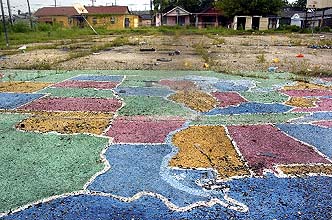Think NOLA
 Photograph by Jennifer Zdon, New Orleans Times-Picayune. Blight and debris remain in several neighborhoods around New Orleans as officials wait for funding to start rebuilding public parks, schools and roads. Some residents feel the most important issue should be the need for housing and are dismayed by the delay in planning.The playground at Mary Church Terrell Elementary School on Broadway St. in Gert Town.
Photograph by Jennifer Zdon, New Orleans Times-Picayune. Blight and debris remain in several neighborhoods around New Orleans as officials wait for funding to start rebuilding public parks, schools and roads. Some residents feel the most important issue should be the need for housing and are dismayed by the delay in planning.The playground at Mary Church Terrell Elementary School on Broadway St. in Gert Town. Is one of the many blogs and websites that links residents and stakeholders on the rebuilding process in New Orleans.
Today's Times-Picayune has quite a long piece on issues in the process, with a pretty accurate (it seems) recounting of the back story and the difficulties. See "N.O. planning puts residents on edge: There's no way to tell what happens when ideas for rebuilding neighborhoods go to decision-makers."
Last week, Fortune Magazine published a great also long story about the rise of civic engagement and connectedness within the city, across sectors that previously didn't have much to do with each other, and an increase in the amount of engagement from the business sectors. See "New Orleans, one year later: The long, strange resurrection of New Orleans."
Many scholars argue that the "Growth Machine" linking business and political elites has never gelled in New Orleans, and that accounts for many of the problems pre- and post-Katrina. Not all scholars agree however. But it is true that the major industrial elements in the area, around the oil industry, are disconnected from the local political networks (the companies are mostly based in Houston and elsewhere, and so is their focus).
And like with most major center cities, as the regions suburbanize and businesses consolidate (especially banks and local retail, which traditionally have been the major stalwarts of Growth Machine politics, along with developers), center cities get the short end of the stick and/or the mushroom treatment. Eventually, events may get to a point where the results of the mushroom treatment get communicated to the world, when the local elites are unable to respond to calamity or other things.
The issues of New Orleans are typical of those faced by most hollowing out center cities in the United States. There, they are perhaps most accelerated. But I know that I am in a minority when I tell people that the wrecked neighborhoods of New Orleans look a lot to me like neighborhoods I've seen in Detroit, Cleveland, Philadelphia, Baltimore, Newark and other places over the years. It's just what happened in New Orleans was fast and furious, accelerated at a pace like nowhere else.
How we deal with the issues in New Orleans will tell us how the United States will address the issues of structural poverty, sprawl, deconcentration, transportation and mobility, land use, energy policy, and the reengineering of a more service oriented focus as part of a much more global economy in the 21st Century.
How long the nation can afford to build an economy on waste is the major question, the waste of resources of all sorts--people, land, capital, energy and other inputs--is likely no longer affordable, especially when one of the major political ideologies is that there is little role for government in making life better for average residents and citizens.
Index Keywords: New-Orleans



0 Comments:
Post a Comment
<< Home